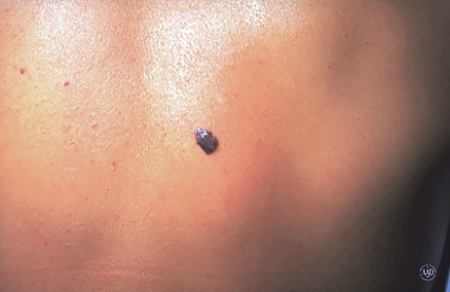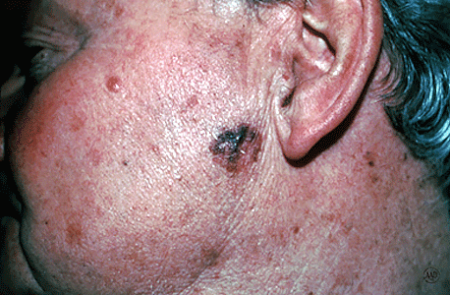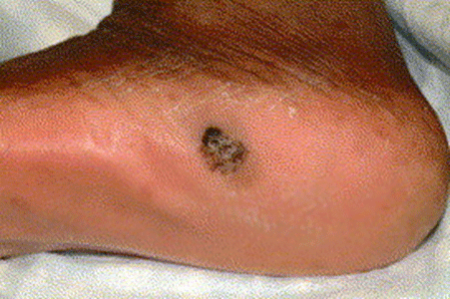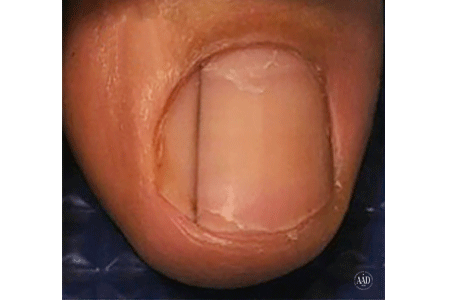Do you need a Dermatology appointment?
MELANOMA
- Appears as dark, either brown or black, lesions.
- Be observant of any moles changing size, shape, elevation, or color.
- The most serious type of skin cancer.
- Allowed to grow, melanoma can spread quickly to other parts of the body. This can be deadly.
MELANOMA RISK FACTORS
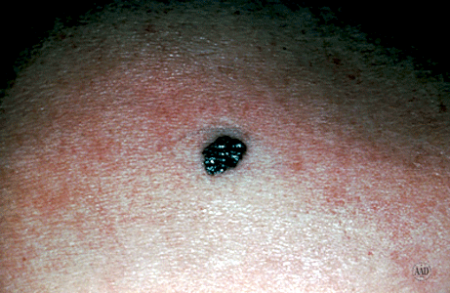
Understanding what causes melanoma and whether you’re at risk of developing the disease can help you prevent it or detect it early when it is easiest to treat and cure.
These factors increase your risk:
- Unprotected or excessive UV exposure from the sun or tanning indoors. Use of tanning beds can increase your chance of melanoma by 75%.
- Weakened immune system due to a medical condition or medications.
- Many moles: The more moles you have on your body, the higher your risk. Also, having large moles (larger than a tip of a pencil eraser) increases the risk.
- Fair skin: Occurs more frequently in people with fair skin.
- Skin cancer history: People who have already had skin cancers run a greater risk of developing the disease in the future.
- Genetics: Skin cancer can run in families – one in every 10 patients has a family member who’s also had the disease.
MELANOMA WARNING SIGNS
Finding skin cancer at an early stage is crucial; early detection can vastly increase your chances for cure. Monthly Self-Exams and Annual Skin Checks done by a Dermatologist are recommended.
Look for anything new, changing or unusual on both sun-exposed and sun-protected areas of the body. Melanomas commonly appear on the legs of women, and the number one place they develop on men is the trunk. Keep in mind, though, they can arise anywhere on the skin, even in areas where the sun doesn’t shine.
Most moles, brown spots and growths on the skin are harmless – but not always. The ABCDEs and the Ugly Duckling sign can help you detect melanoma.
The ABCDEs
To help people find a possible melanoma on their skin, dermatologists created the ABCDEs:
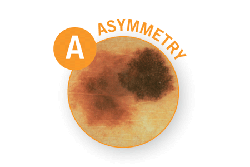 |
A is for Asymmetry One half of the spot is unlike the other half. |
|
 |
B is for Border The spot has an irregular, scalloped, or poorly defined border. |
|
 |
C is for Color The spot has varying colors from one area to the next, such as shades of tan, brown or black, or areas of white, red, or blue. |
|
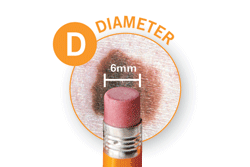 |
D is for Diameter While melanomas are usually greater than 6 millimeters, or about the size of a pencil eraser, when diagnosed, they can be smaller. |
|
 E is for Evolving |
||
If you find a spot on your skin that has any of the ABCDEs, schedule an appointment with our experts. The following pictures can help you see how the ABCDEs can appear on the skin.
How many of the ABCDEs can you find in the following pictures?
Melanoma that looks like an odd-shaped mole
Would you mistake these melanomas for odd-shaped moles? Both show the A (asymmetrical shape) and B (border uneven) of melanoma. The melanoma on the right shows the C (color varies).
Melanoma that looks like a sore
Melanoma often contains shades of brown, black, or tan, but some can be red or pink, such as the one shown here. Still you can see some of the ABCDEs here. The spot shows the A (asymmetrical shape) and B (uneven border).
Melanoma that looks like a firm, raised growth
This one is growing up and looks like a firm, raised growth. Did you notice the A (asymmetrical shape) and B (uneven border)?
Melanoma that looks like an age spot
This one is spreading out as it grows. Did you notice the A (asymmetrical shape), B (uneven border), C (color varies), and D (diameter is bigger than a pencil eraser)?
Melanomas that could be mistaken for a common skin problem
Looks like a bruise Melanoma can develop anywhere on the skin, including the bottom of the foot, where it can look like a bruise as shown here.
Looks like a cyst This reddish nodule looks a lot like a cyst, but testing proved that it was a melanoma.
Dark spot In people of African descent, melanoma tends to develop on the palm, bottom of the foot, or under or around a nail. Did you spot the asymmetry, uneven border, varied color, and diameter larger than that of a pencil eraser?
Dark line beneath a nail Melanoma can develop under a fingernail or toenail, looking like a brown line as shown here. While this line is thin, some are much thicker. The lines can also be much darker.
DO MELANOMAS HURT?
You can have melanoma without feeling any pain or discomfort. For many people, the only sign of this skin cancer is a spot that has some of the ABCDEs or a line beneath a nail. They also can itch, be painful, and/or bleed.

A dermatologist biopsies the suspicious tissue and sends it to a lab, where a dermatopathologist determines whether cancer cells are present.
After the disease is diagnosed and the type is identified, the next step is for your medical team to identify the stage of the disease. This may require additional tests including imaging such as PET scans, CT scans, MRIs ,and blood tests.
The stage of is determined by several factors, including how much the cancer has grown, whether the disease has spread (metastasized) and other considerations. Melanoma staging is complex, but crucial. Knowing the stage helps doctors decide how to best treat your disease and predict your chances of recovery.
TREATMENT
While melanoma is one of the most dangerous forms of skin cancer, promising new treatment options are improving quality of life and increasing survival rates for patients with advanced melanoma. If you’ve been diagnosed, your treatment choices depend on the stage of the disease, the location of the tumor and your overall health.
Treatment options include:
- Surgical removal
- Immunotherapy
- Targeted therapy
- Chemotherapy
- Radiation
Ask your dermatologist to clearly explain the options that might work best for you, including details about the benefits and risks.


